New Castle, Delaware 作者: 来源: 发布时间:2021-07-20
I.Population and Area
₋Area
Land: 3.52 sq mi (9.12 km2)
₋Population
Total: 5,285
Density: 1,550.32/sq mi (598.58/km2)
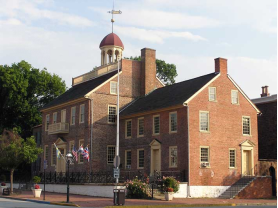
II.Natural Geography
₋New Castle is a city in New Castle County, Delaware, United States, six miles (10 km) south of Wilmington, and situated on the Delaware River. According to the 2010 Census, the population of the city is 5,285.
₋New Castle was originally settled by the Dutch West India Company in 1651, under the leadership of Peter Stuyvesant, on the site of a former aboriginal village, "Tomakonck" ("Place of the Beaver"), to assert their claim to the area based on a prior agreement with the aboriginal inhabitants of the area. The Dutch originally named th e settlement Fort Casimir, but this was changed to Fort Trinity (Swedish: Trefaldighet) following its seizure by the colony of New Sweden on Trinity Sunday, 1654. The Dutch conquered the entire colony of New Sweden the following year and rechristened the fort Nieuw-Amstel ("New Amstel"). This marked the end of the Swedish colony in Delaware as an official entity, but it remained a semi-autonomous unit within the New Netherland colony and the cultural, social, and religious influence of the Swedish settlers remained strong. As the settlement grew, Dutch authorities laid out a grid of streets and established the town common (The "Green"), which continue to this day.
₋In 1664, the English seized the entire New Netherland colony in the Second Anglo-Dutch War. They changed the name of the town to "New Castle" and made it the capital of their Delaware Colony. The Dutch regained the town in 1673 during the Third Anglo-Dutch War but it was returned to Great Britain the next year under the Treaty of Westminster. In 1680, New Castle was conveyed to William Penn by the Duke of York by livery of seisin and was Penn's landing place when he first set foot on American soil on October 27, 1682. This transfer to Penn was contested by Lord Baltimore and the boundary dispute was not resolved until the survey conducted by Mason and Dixon, now famed in history as the Mason–Dixon line.
₋Prior to the establishment of Penn's Philadelphia, New Castle was a center of government. After being transferred to Penn, Delaware's Swedish, Dutch, and English residents used to the relaxed culture of the Restoration monarchy grew uncomfortable with the more conservative Quaker influence, so Delaware petitioned for a separate legislature, which was finally granted in 1702. Delaware formally broke from Pennsylvania in 1704. New Castle again became the seat of the colonial government, thriving with the various judges and lawyers that fueled the economy. Many smaller houses were torn down and replaced in this era. In February 1777, John McKinly was elected the first President of Delaware (a title later renamed "Governor"). During the Revolution, when New Castle was besieged by William Howe, the government elected to move its functions south to Dover in May 1777. McKinley was captured by the British and held prisoner for several months. New Castle remained the county seat until after the Civil War, when that status was transferred to Wilmington. Three signers of the Declaration of Independence were from New Castle—Thomas McKean, George Read, and George Ross.
₋The 16-mile (26 km) portage between the Delaware River and Chesapeake Bay saved a 400-mile (640 km) trip around the Delmarva Peninsula, so this brought passengers, goods, and business to New Castle's port. In the years following the Revolution, a turnpike was built to facilitate travel between the two major waterways. Later, New Castle became the eastern terminus of the New Castle and Frenchtown Railroad, the second-oldest rail line in the country, launched in 1828 with horse-drawn rail cars, then converting to steam power when an engine was purchased from Great Britain in 1832. The line traversed the Delmarva Peninsula, running to the Elk River, Maryland, from where passengers changed to packet boats for further travel to Baltimore and points south. This helped the New Castle economy to further boom; however, by 1840, rail lines were in place between Philadelphia and Baltimore, which had a stop in Wilmington, thus leaving New Castle to deal with a substantial decline in traffic and revenue.
₋The decline in New Castle's economy had the long-range fortunate effect of preventing most residents from making any significant structural changes to their homes. So, the many buildings of historic New Castle look much as they did in the colonial and Federal periods.
₋New Castle has a tradition, dating back to 1927, of tours of historical homes, churches, and gardens. These tours, called "A Day in Olde New Castle", are usually held on the third Saturday of May. Householders dress in colonial costumes and an admittance fee is collected which is used toward the maintenance of the town's many historic buildings. In June the town holds its annual Separation Day celebration.
₋On April 28, 1961, an F3 tornado hit the north side. Although no fatalities or injuries occurred, it was the only tornado of this magnitude ever recorded in Delaware.
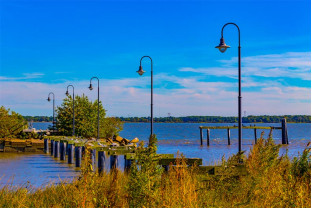
III.GDP
₋The average salary in New Castle, DE is $59k. Trends in wages increased by 0.3 percent in Q1 2020. The cost of living in New Castle, DE is 100 percent higher than the national average. The most popular occupations in New Castle, DE are Project Manager, (Unspecified Type / General), Operations Manager, and Human Resources (HR) Generalist which pay between $35k and $103k per year. The most popular employers in New Castle, DE are Citibank, J.P. Morgan Chase & Co. (JPMCC), and Discover Financial Services LLC.
₋Website: https://www.payscale.com/research/US/Location=New-Castle-DE/Salary
IV.Industrial Characteristics
₋Transportation
₋Delaware Route 9 runs southwest-to-northeast through New Castle, passing through the city along 7th Street, Washington Street, Delaware Street, and Ferry Cut Off Street; the route bypasses the historic area. DE 9 heads north to Wilmington and south to Delaware City. Delaware Route 141 heads north from New Castle on Basin Road and provides a bypass to the west of Wilmington. Delaware Route 273 heads west from New Castle on Frenchtown Road and provides access to Christiana and Newark. Several important roads are located just outside the city limits. U.S. Route 13 and U.S. Route 40 pass northwest of New Castle along Dupont Highway, with access to the city via DE 141 and DE 273. Interstate 295 passes north of New Castle and crosses the Delaware River on the Delaware Memorial Bridge to New Jersey, with DE 9 providing access to New Castle from I-295.
₋The Wilmington Airport (formerly New Castle Airport) is located northwest of New Castle along US 13/US 40. The airport offers general aviation and formerly had commercial air service. The nearest airport to New Castle with commercial air service is the Philadelphia International Airport in Philadelphia.
₋A freight line operated by the Norfolk Southern Railway passes through New Castle. The nearest passenger rail station to New Castle is Wilmington station in Wilmington, which is served by Amtrak and SEPTA Regional Rail's Wilmington/Newark Line.
₋DART First State provides bus service to New Castle along Route 15 and Route 51, which both run between downtown Wilmington and the Christiana Mall and offer connections to multiple bus routes serving points across northern New Castle County.
₋Utilities
₋The Municipal Services Commission of the City of New Castle provides electricity and water to the city. The electric department is a member of the Delaware Municipal Electric Corporation. Natural gas service in New Castle is provided by Delmarva Power, a subsidiary of Exelon. The city's Public Works department provides trash and recycling collection to New Castle.
V.Attractions
1.Battery Park
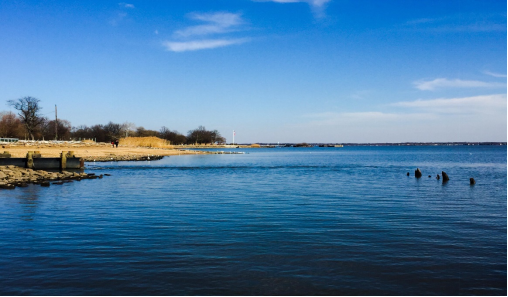
₋Battery Park is a public park in New Castle, Delaware bordered by West 3rd Street, Delaware Street and the Delaware River. The Separation Day celebration commemorating the political division of Delaware from Pennsylvania is held here in mid-June annually.
₋Address: 1 Delaware St, New Castle, DE 19720, United States
₋Phone: +1 302-322-9812
₋Website: https://newcastlecity.delaware.gov/293-2/
2. Delaware Memorial Bridge
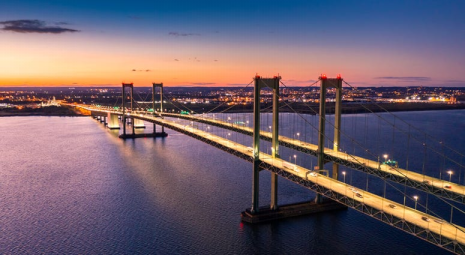
₋The Delaware Memorial Bridge is a twin suspension bridge crossing the Delaware River. The toll bridges carry Interstate 295 and U.S. Route 40 between Delaware and New Jersey. The bridge was designed by the firm known today as HNTB with consulting help from engineer Othmar Ammann, whose other designs include the Walt Whitman Bridge (which is similar in appearance to each of the twin Delaware Memorial Bridges, except for being a single span with more lanes) and the Verrazzano-Narrows Bridge. It is also one of only two crossings of the Delaware River with both U.S. Highway and Interstate Highway designations, the other being the Benjamin Franklin Bridge.
₋The bridges provide a regional connection for long-distance travelers. While not a part of Interstate 95, they connect two parts of the highway: the Delaware Turnpike (Interstate 95 in Delaware) on the south side with the New Jersey Turnpike (later Interstate 95 in New Jersey) on the north side. They also connect Interstate 495, U.S. Route 13, and Route 9 in New Castle, Delaware with U.S. Route 130 in Pennsville Township, New Jersey (at the settlement of Deepwater, New Jersey).
₋The bridges are dedicated to those from both New Jersey and Delaware who died in World War II, the Korean War, the Vietnam War, and the Persian Gulf War. On the Delaware side of the bridge is a War Memorial, visible from the northbound-side lanes. The toll facility is operated by the Delaware River and Bay Authority.
₋The Delaware Memorial Bridge is the southernmost fixed vehicular crossing of the Delaware River and the only fixed vehicular crossing between Delaware and New Jersey. However, at Fort Mott, N.J., there is a small amount of land on the New Jersey side of the river that is part of the State of Delaware, and thus there are pedestrian crossings in between those states, but not spanning the river. The Cape May–Lewes Ferry provides an alternate route between travelers from New Jersey and the Northeastern States to southern Delaware.
₋Address: I-295 &, Route 9, Wilmington, DE 19801, United States
₋Website: http://www.drba.net/delawarememorialbridge.aspx
3. New Castle Court House Museum
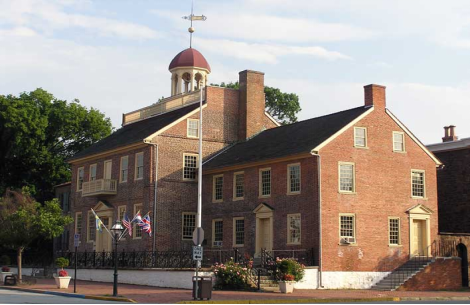
₋The New Castle Court House Museum is the center of a circle with a 12-mile radius that defines most of the border between the states of Delaware and Pennsylvania and parts of the borders between Delaware and New Jersey and Maryland.
₋It is one of the oldest courthouses in the United States and has played a role in a number of historic events. It was declared a National Historic Landmark in 1972. The building is also a contributing property to a second National Historic Landmark, the New Castle Historic District. It is part of First State National Historical Park.
₋Address: 211 Delaware St, New Castle, DE 19720, United States
₋Phone: +1 302-323-4453
₋Website: https://history.delaware.gov/ncch_main/
VI.History
₋New Castle was originally settled by the Dutch West India Company in 1651, under the leadership of Peter Stuyvesant, on the site of a former aboriginal village, "Tomakonck" ("Place of the Beaver"), to assert their claim to the area based on a prior agreement with the aboriginal inhabitants of the area. The Dutch originally named the settlement Fort Casimir, but this was changed to Fort Trinity (Swedish: Trefaldighet) following its seizure by the colony of New Sweden on Trinity Sunday, 1654. The Dutch conquered the entire colony of New Sweden the following year and rechristened the fort Nieuw-Amstel ("New Amstel"). This marked the end of the Swedish colony in Delaware as an official entity, but it remained a semi-autonomous unit within the New Netherland colony and the cultural, social, and religious influence of the Swedish settlers remained strong. As the settlement grew, Dutch authorities laid out a grid of streets and established the town common (The "Green"), which continue to this day.
₋In 1664, the English seized the entire New Netherland colony in the Second Anglo-Dutch War. They changed the name of the town to "New Castle" and made it the capital of their Delaware Colony. The Dutch regained the town in 1673 during the Third Anglo-Dutch War but it was returned to Great Britain the next year under the Treaty of Westminster. In 1680, New Castle was conveyed to William Penn by the Duke of York by livery of seisin and was Penn's landing place when he first set foot on American soil on October 27, 1682. This transfer to Penn was contested by Lord Baltimore and the boundary dispute was not resolved until the survey conducted by Mason and Dixon, now famed in history as the Mason–Dixon line.
₋Prior to the establishment of Penn's Philadelphia, New Castle was a center of government. After being transferred to Penn, Delaware's Swedish, Dutch, and English residents used to the relaxed culture of the Restoration monarchy grew uncomfortable with the more conservative Quaker influence, so Delaware petitioned for a separate legislature, which was finally granted in 1702. Delaware formally broke from Pennsylvania in 1704. New Castle again became the seat of the colonial government, thriving with the various judges and lawyers that fueled the economy. Many smaller houses were torn down and replaced in this era. In February 1777, John McKinly was elected the first President of Delaware (a title later renamed "Governor"). During the Revolution, when New Castle was besieged by William Howe, the government elected to move its functions south to Dover in May 1777. McKinley was captured by the British and held prisoner for several months. New Castle remained the county seat until after the Civil War, when that status was transferred to Wilmington. Three signers of the Declaration of Independence were from New Castle—Thomas McKean, George Read, and George Ross.
₋The 16-mile (26 km) portage between the Delaware River and Chesapeake Bay saved a 400-mile (640 km) trip around the Delmarva Peninsula, so this brought passengers, goods, and business to New Castle's port. In the years following the Revolution, a turnpike was built to facilitate travel between the two major waterways. Later, New Castle became the eastern terminus of the New Castle and Frenchtown Railroad, the second-oldest rail line in the country, launched in 1828 with horse-drawn rail cars, then converting to steam power when an engine was purchased from Great Britain in 1832. The line traversed the Delmarva Peninsula, running to the Elk River, Maryland, from where passengers changed to packet boats for further travel to Baltimore and points south. This helped the New Castle economy to further boom; however, by 1840, rail lines were in place between Philadelphia and Baltimore, which had a stop in Wilmington, thus leaving New Castle to deal with a substantial decline in traffic and revenue.
₋The decline in New Castle's economy had the long-range fortunate effect of preventing most residents from making any significant structural changes to their homes. So, the many buildings of historic New Castle look much as they did in the colonial and Federal periods.
₋New Castle has a tradition, dating back to 1927, of tours of historical homes, churches, and gardens. These tours, called "A Day in Olde New Castle", are usually held on the third Saturday of May. Householders dress in colonial costumes and an admittance fee is collected which is used toward the maintenance of the town's many historic buildings. In June the town holds its annual Separation Day celebration.
₋On April 28, 1961, an F3 tornado hit the north side. Although no fatalities or injuries occurred, it was the only tornado of this magnitude ever recorded in Delaware.
VII.Other Information
₋Transportation
₋Delaware Route 9 runs southwest-to-northeast through New Castle, passing through the city along 7th Street, Washington Street, Delaware Street, and Ferry Cut Off Street; the route bypasses the historic area. DE 9 heads north to Wilmington and south to Delaware City. Delaware Route 141 heads north from New Castle on Basin Road and provides a bypass to the west of Wilmington. Delaware Route 273 heads west from New Castle on Frenchtown Road and provides access to Christiana and Newark. Several important roads are located just outside the city limits. U.S. Route 13 and U.S. Route 40 pass northwest of New Castle along Dupont Highway, with access to the city via DE 141 and DE 273. Interstate 295 passes north of New Castle and crosses the Delaware River on the Delaware Memorial Bridge to New Jersey, with DE 9 providing access to New Castle from I-295.
₋The Wilmington Airport (formerly New Castle Airport) is located northwest of New Castle along US 13/US 40. The airport offers general aviation and formerly had commercial air service. The nearest airport to New Castle with commercial air service is the Philadelphia International Airport in Philadelphia.
₋A freight line operated by the Norfolk Southern Railway passes through New Castle. The nearest passenger rail station to New Castle is Wilmington station in Wilmington, which is served by Amtrak and SEPTA Regional Rail's Wilmington/Newark Line.
₋DART First State provides bus service to New Castle along Route 15 and Route 51, which both run between downtown Wilmington and the Christiana Mall and offer connections to multiple bus routes serving points across northern New Castle County.
₋Utilities
₋The Municipal Services Commission of the City of New Castle provides electricity and water to the city. The electric department is a member of the Delaware Municipal Electric Corporation. Natural gas service in New Castle is provided by Delmarva Power, a subsidiary of Exelon. The city's Public Works department provides trash and recycling collection to New Castle.
VIII.Contact Information
₋Government
Major: Michael J. Quaranta
₋City Hall
₋Address:
220 Delaware Street
New Castle, DE 19720
₋Phone: (302) 322-9801
₋Tax Line: (302) 322-9804
₋Fax: (302) 322-9814
₋Website: https://newcastlecity.delaware.gov/contact-form/
